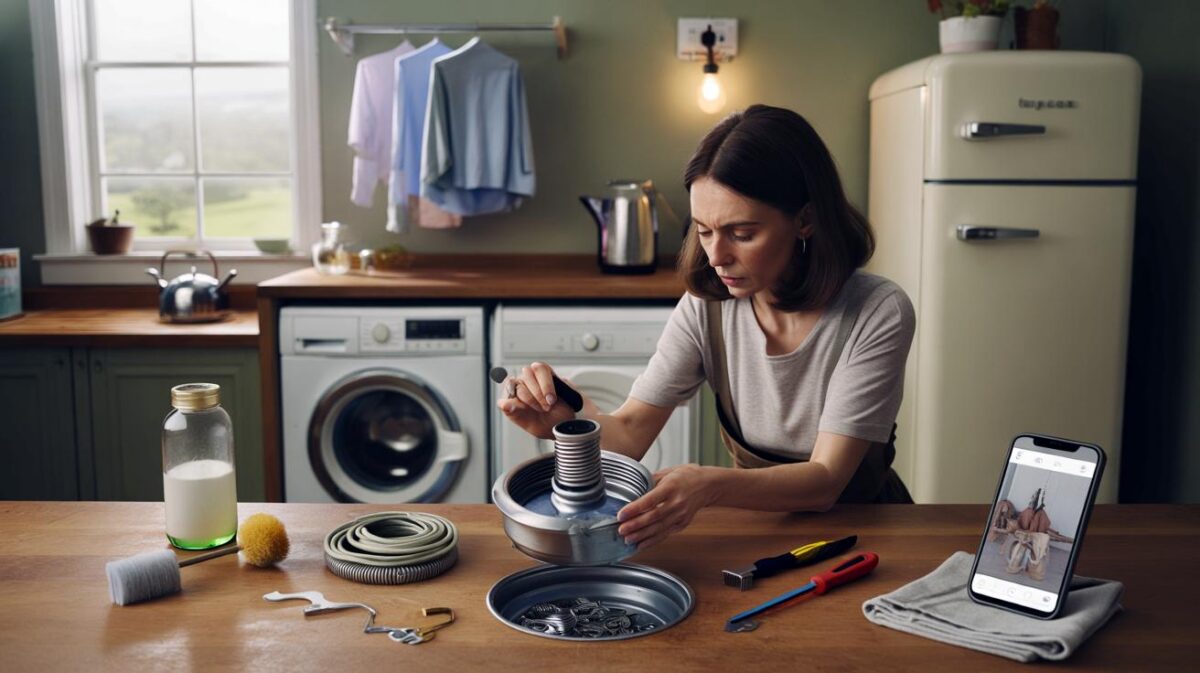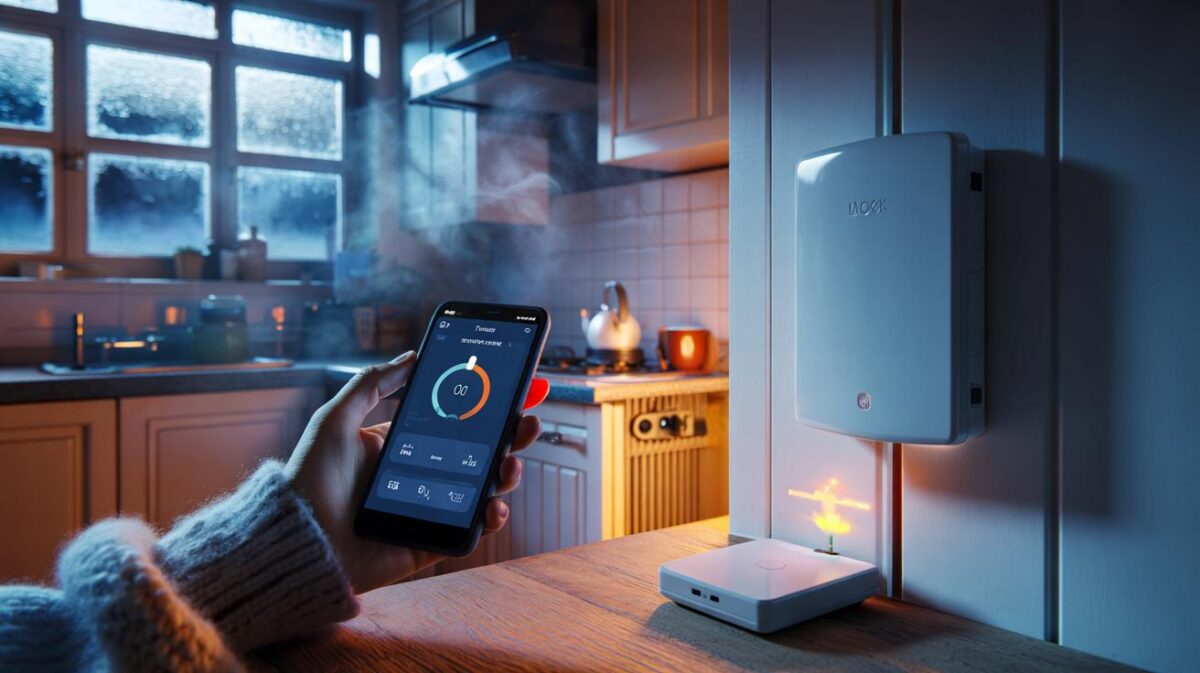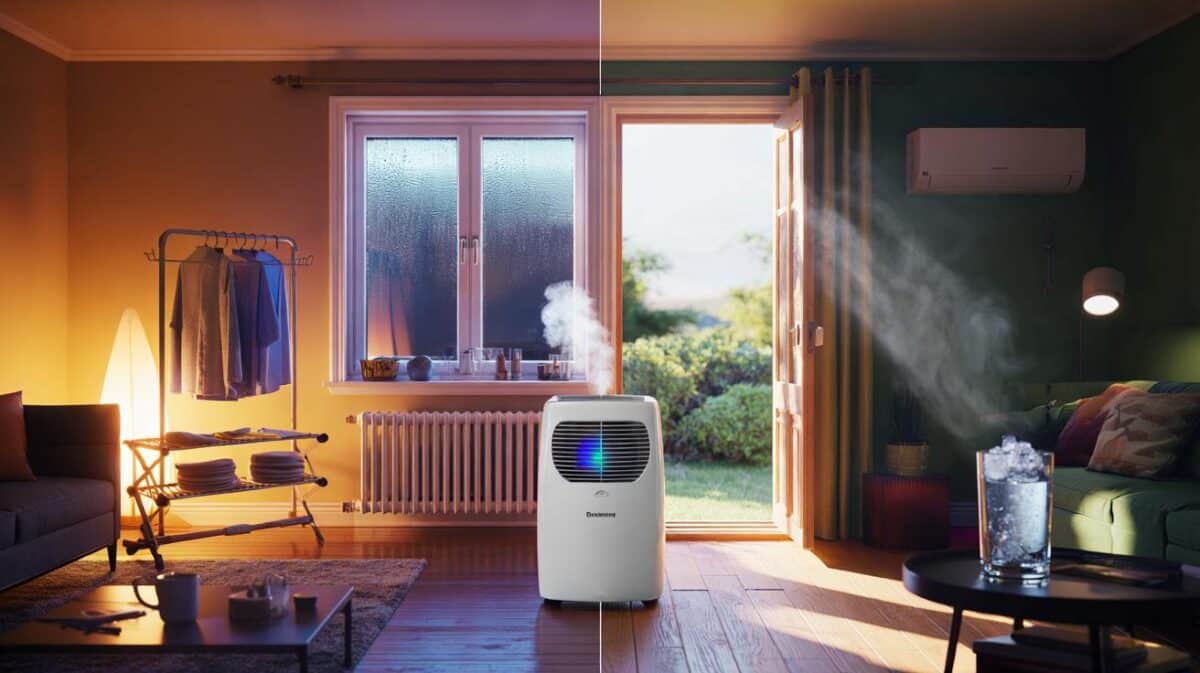Condensation on the windows, a musty-smelling wardrobe, towels never quite dry — a dehumidifier feels like a small flat’s secret weapon. Picking the right one, though, can feel like guesswork with humming boxes that all promise the same miracle.
The sills bead up, almost theatrically, as if to say: you thought winter was over? The radiator gives a half-hearted tick.
My neighbour swears by her compact dehumidifier. She moves it from the hall to the bedroom like a loyal pet, and claims her laundry dries overnight without that damp funk. The machine’s low purr is oddly reassuring, like a fridge you actually want in earshot.
Later, I open a wardrobe and catch that sweet-cold smell of mould starting. A single black dot on a white wall winks back. You notice this stuff once, and then you see it everywhere. The air tells the truth.
Small-flat moisture is a numbers game, not a vibe
In a tight space, steam has nowhere to go. Showers, cooking, even breathing can add litres of water to the air by lunchtime. That’s the **small flat syndrome**: moisture stacks up quietly, then crashes into your coldest surfaces at night.
So the “right” dehumidifier isn’t about brand first. It’s about how much water it can pull daily, how it behaves at cool temperatures, and whether it plays nicely with your routine. Living room full of plants? Tiny bathroom with no fan? These things matter more than a glossy box.
Most one-beds in the UK sit somewhere between 30 and 55 sqm. In that range, a 10–12-litre-per-day unit often hits the sweet spot for everyday moisture and weekend laundry. If your place runs cool, a desiccant model stays punchy when a compressor would sulk. And noise matters when every room is a door away. Quiet and steady beats loud and heroic.
Capacity, model type and where to park it
Think capacity first: a 10–12L/day unit suits most studios and small one-beds. Go 16L if you dry clothes indoors often, cook nightly, or share with two or more people. A **right-size, right-place** unit will cycle off more often, saving energy while keeping the air balanced.
Compressor models are energy-thrifty in heated rooms; they like 18°C and up, and they’re the default for most lounges and bedrooms. Desiccant machines are brilliant under 15°C and add a whisper of warmth to chilly corners, lofts and wintery bathrooms. If your flat is draughty or you keep the heating low, desiccant can feel like cheating — it just gets on with it.
Placement decides half your results. Park it in a central spot with airflow — a hallway, living room doorway, or near the drying rack. Doors ajar lets the machine “patrol” the entire flat. For laundry, move it within two metres of the rack and select laundry mode if you have it. For showers, run it 30–60 minutes after, bathroom door open to the hall. Target 45–50% relative humidity and let the humidistat do the rest.
Settings that work in real life
Use the built-in humidistat. Set it between 45% and 50% and forget the constant fiddling. Hit laundry mode only when drying clothes, then return to your everyday set-point. Timers are gold: schedule a 2–3 hour burst after dinner and an hour after showers. You’ll see the windows change first, then the wardrobe smell fades.
Common trip-ups are painfully normal. Running with a window cracked “for fresh air” just invites more wet air. Shoving the unit in a corner starves it of flow. Emptying the tank too late makes the machine sulk in standby. Let’s be honest: nobody does that every day.
If your unit has fan speeds, pick low for normal days and high only for wet spikes. A cheap digital hygrometer on a bookshelf lets you see the pattern — morning spike, calm afternoon, laundry bump. You’re not chasing perfection, you’re steering trends.
“The best setting is the one you never think about. Set 50%, place it right, and let physics clock in.”
- Leave 20–30 cm clearance around the intake and outlet.
- Keep doors ajar for whole-flat drying, closed for zone drying (e.g., laundry room).
- Use continuous drain if you’re away or forgetful; a simple hose into a sink solves the tank dance.
- Clean the dust filter monthly; dust kills extraction and raises noise.
Mistakes you can dodge
Buying by headline litres alone. That number is from warm, humid test rooms. In a cool flat, real extraction drops. Choose model type for your average temperature and consider noise at the distance you’ll live with — 39 dB on paper versus the tabletop hum by your sofa is not the same story.
Running windows wide open while the dehumidifier is on. You’re drying the street. Ventilate in short, sharp bursts, then let the machine polish what’s left. Oversizing is another odd trap: a big unit roaring to 35% RH can parch wood and skin. Keep that **45–50% RH** target and you’ll feel the comfort, not the thirst.
Ignoring placement. If the unit can’t “see” your wettest sources — drying rack, kitchen doorway, bathroom corridor — it chases ghosts. Move it like a lamp: where you need light, you put it closer. That little habit beats any fancy app.
A small-flat method that actually sticks
Start with a 10–12L unit for a studio or one-bed, or 16L if you dry clothes indoors often. Compressor for rooms you heat, desiccant for cooler spaces or off-heat habits. Place it centrally with breathing room, doors ajar for whole-flat days; pull it near the rack for laundry nights. Set 50%, use laundry mode selectively, and let it idle off. If you can, add a £10 hygrometer to learn your pattern. We’ve all had that moment when the first clear-pane morning feels like a tiny miracle. The clothes smell like nothing, which is exactly what you want. And the mould? It stops trying to introduce itself.
A true-to-life example
Jay, renting in Bristol, battled fogged windows and a sulky wardrobe. After a week of towel-dabbing sills, he bought a 12L compressor model with a quiet mode and auto-defrost. He parked it in the hallway, set 50%, and ran laundry mode on wash days.
The first weekend he clocked a full tank by noon after showers and pasta night. By week two, the windows were clear by 9am and the bedroom no longer smelled like a wet book. He stopped wiping and stopped worrying. That’s the win small flats need.
The numbers matched the feeling. Energy use averaged 0.2–0.3 kWh per hour on low, less than a tumble dryer by a mile. He ran it in bursts, watched the hygrometer settle around 48%, and slept quieter than the fan. A small habit, a big shift.
Settings and slip-ups: the smarter way to run it
Try the “zone-first” method. After showers, open the bathroom door, place the unit in the hallway facing the bathroom, and run for 45 minutes. For laundry, move it near the rack on high for two hours, then drop to auto at 50%. This rhythm removes the peaks before they soak back into walls.
Don’t chase zero humidity. Air that’s too dry feels scratchy and makes wooden floors complain. If you hear rattles, clean the filter; if you smell must, check for hidden wet sources like a dripping trap or overwatered plants. **Small tweaks beat big overhauls.**
You’ll notice different “seasons” inside your flat — curry night, towel-wash day, windows-open spring. Treat the settings like you treat lighting: bright when you need focus, soft when you don’t.
“Moisture is like traffic. Clear the rush hour, and the roads stay flowing.”
- Use a timer to catch predictable spikes (post-shower, cooking, laundry).
- If your flat runs cold, consider a desiccant unit for winter months.
- Avoid tucking the machine behind furniture — it needs clear intake and outflow.
- A short, sharp vent (5 minutes window open) before running is fine; long drafts are not.
Choosing confidence, not guesswork
There’s a quiet pleasure in a home that smells of… nothing. Choose capacity to match your space and habits, choose model type for your temperature, and choose placement like you would a lamp — where it can shine. A simple humidistat setting does the heavy lifting while you get on with life. When friends ask why your place feels fresher, you won’t talk about specs, you’ll talk about mornings with clear glass and laundry that dries without drama. The right dehumidifier doesn’t feel like a gadget. It feels like airflow you can trust. And once you hear that soft purr, you might wonder why you waited so long.
| Key points | Detail | Reader Interest |
|---|---|---|
| Capacity and size | 10–12L/day suits most studios/one-beds; 16L if drying laundry indoors often | Avoids guesswork and wasted spend |
| Compressor vs desiccant | Compressor for heated rooms; desiccant for cooler flats and winter use | Better performance in your actual conditions |
| Settings and placement | Set 45–50% RH, timer after showers/cooking, central spot with doors ajar | Faster clear windows, fresher wardrobes, lower bills |
FAQ :
- What size dehumidifier for a studio?A 10–12L/day unit usually handles a studio, with 16L if you dry clothes indoors regularly.
- Where should I place it in a small flat?Central hallway or living room doorway with 20–30 cm clearance; move near the drying rack on wash days.
- Should I run it overnight?Yes if humidity stays high; otherwise set 50% and let the humidistat idle it. Night mode helps if noise bothers you.
- Desiccant or compressor for UK winters?Desiccant if your flat runs below ~15°C; compressor if rooms stay heated above ~18°C.
- Best setting to dry laundry faster?Use laundry mode or high fan for 1–2 hours near the rack, then switch back to 45–50% RH.








